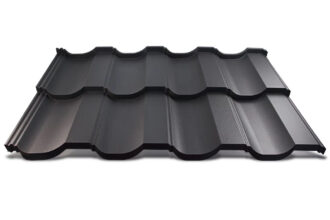A roof soffit is the roof trim that sits under the roof’s eaves, i.e. between the lower ends of the tiles and the edge of the wall. Its main purpose is to protect the roof structure from the weather and provide an aesthetically pleasing finish to the roof and building façade. Find out which type of soffit will work for your roof!
What does roof soffit consist of?
The soffit is made up of the following components:
- Support battens – wooden or metal rods that are installed parallel to the edge of the wall. These battens provide support and underlay for the roof soffit.
- Soffit material – the choice of material depends on aesthetic and functional requirements as well as budget. Wood (e.g., pine, spruce or larch boards), PVC, fibre cement, aluminium or sheet steel are the most commonly used materials. The material is fixed to the support battens, creating a uniform soffit surface.
- Flashing – includes sheet metal components used to ensure the tightness of the structure. These elements include, for example, eaves sections or corners.
- Ventilation – to ensure adequate air circulation and to protect against moisture and condensation, the roof soffit must be adequately ventilated. Various solutions are used, such as ventilation slots, grilles or special ventilation strips.
- Thermal insulation (optional) – in some cases, an extra layer of thermal insulation is used under the roof underlay to better protect the building from heat loss.
The installation of the roof soffit should be carried out in accordance with the rules of the trade and the material manufacturer’s guidelines. Remember to choose the right material and match it to the style and requirements of the building.
What are the functions of a roof soffit?
The soffit protects the roof structure, insulation and non-visible parts of the façade from the effects of the weather, such as rain, snow, wind or solar radiation. It also prevents birds, rodents and insects from entering the roof space.
The soffit, especially with properly designed vents, ensures adequate air circulation under the roof. Good ventilation in this area helps maintain the right temperature in the house and prevents condensation and mould formation. Roof soffit also contributes to the house’s appearance, improving its aesthetics and linking the roof to the façade. It is available in a variety of visual variations to match the leading style of the building. Notably, the soffit hides certain roof structure elements, such as rafters, insulation or fittings. This makes the whole structure look neat and aesthetically pleasing.
How do I choose a soffit for a detached house roof?
The choice of roof soffit for a detached house depends on several factors worth considering to achieve an optimal result, both aesthetically and functionally. How is this done?
- Choose a material that matches the style and design of your home and is highly weather resistant. The most popular materials are wood, PVC, aluminium and fibre cement. Each has its advantages and disadvantages, so it is good to consider durability, weather resistance, maintenance and price.
- Then choose a colour and finish for the soffit to match the colour of the roof tiles, facade and windows. You can select a single-colour, wood-effect or other patterned soffit to achieve a consistent and aesthetically pleasing look for your home. It all depends on your vision!
- It is important to ensure adequate ventilation under the roof to maintain the right temperature and prevent dampness and mould. Ensure that the roof soffit system you choose provides sufficient ventilation or the ability to install additional ventilation systems. Failure to do so could damage the roof structure and cost you a lot of money to repair.
- Choose a roof soffit that is easy to install and requires little maintenance. Some materials, such as wood, require regular painting and impregnation, while others, such as PVC or aluminium, are virtually maintenance-free.
- Compare the costs of different roof soffit materials and their installation. Choose an option that suits your budget, but remember that cheaper materials may be less durable or require more maintenance. By investing in solid materials and starting construction, you will likely save money on future repairs.
- Choose roof soffit that is weather, UV and rot-resistant. Be sure to check the warranty offered by the manufacturer, as this is a good indication of the quality of the product.
When considering the above factors, it is worth consulting professionals such as roofers or designers. Specialists will help you make your final choice and ensure your roof soffit is installed correctly.
Types of roof soffit
Roof soffits differ primarily in the material they are made of. Which are the most popular?
- Timber soffits are a classic choice, suitable for most roof types. They are durable, environmentally friendly and give a natural look. However, it requires regular maintenance, in the form of painting and waterproofing, to ensure its long life.
- Plastic soffits, such as PVC, are resistant to weather, moisture and rot. They are easy to install, maintenance-free and come in a variety of colours and finishes that can mimic the look of wood. PVC soffits are usually cheaper than timber, but can be less resistant to mechanical damage.
- Aluminium soffits are durable, lightweight, corrosion-resistant and virtually maintenance-free. What’s more, you will get it in a variety of colours and finishes, so you can effortlessly match it to the façade and roof. Aluminium soffits may be slightly more expensive than PVC, but they are more durable.
- Cement fibre soffits are highly durable and resistant to weather, moisture, fire and rot. This type of soffit comes in a variety of colours and finishes that can mimic the look of wood. The material requires special care during installation as it is heavier and more fragile than the other options.
The soffit must meet your needs and budget, whilst providing adequate structural ventilation. It is best to leave the soffit installation to professionals who will ensure that it is airtight and sound.


